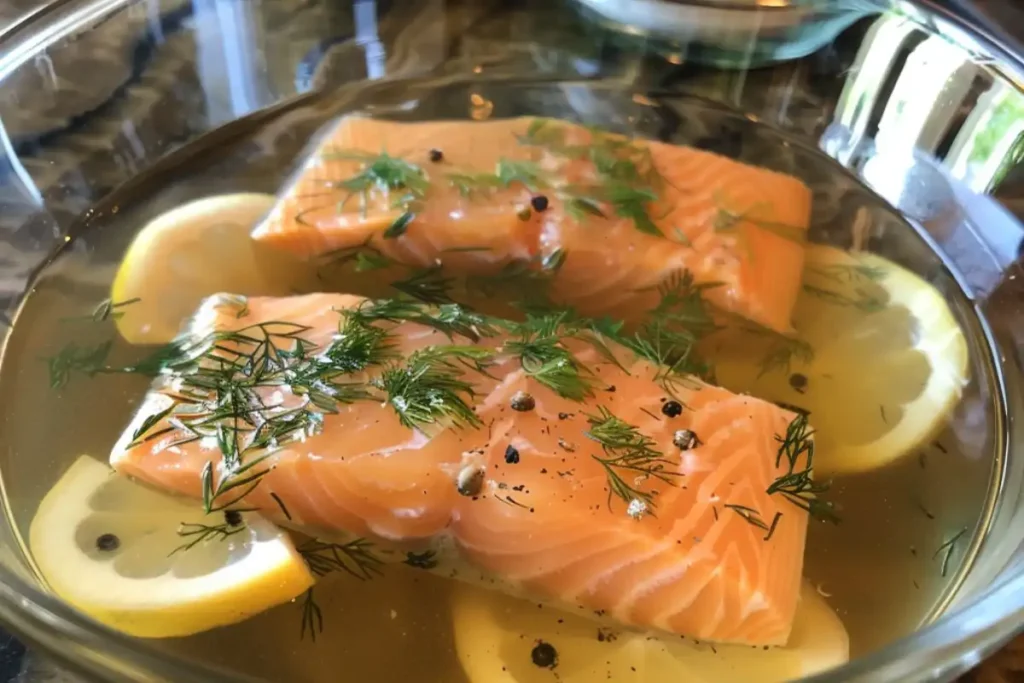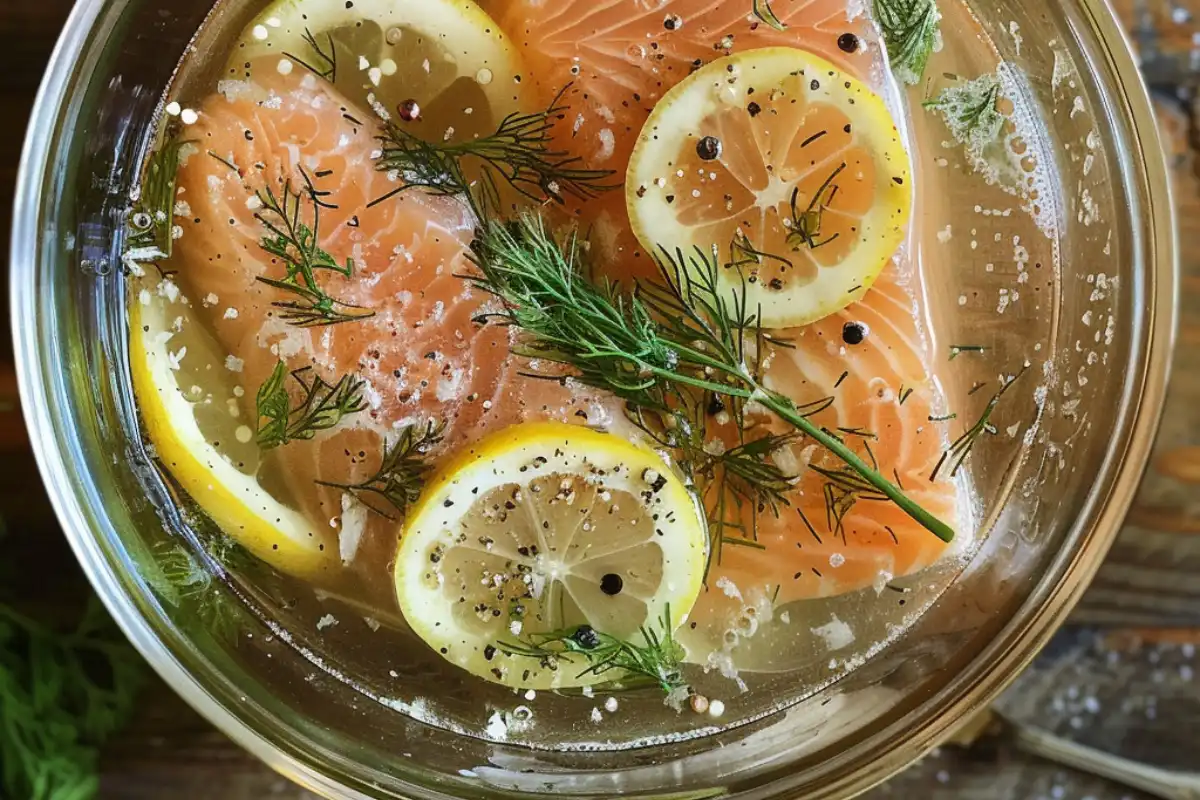Salmon is not only a healthy and nutrient-rich fish but also a favorite among seafood lovers due to its versatility and rich flavor. However, for many home cooks, preparing salmon can sometimes feel intimidating, especially if you’re concerned about that notorious fishy smell or unsure how to lock in the fish’s moisture. One of the most effective methods to prepare salmon is by soaking it before cooking, but what do you soak salmon in before cooking? In this comprehensive guide, we’ll explore various soaking methods that will make your salmon dishes even more delicious and moist.
Why Should You Soak Salmon Before Cooking?
Soaking salmon before cooking is a valuable technique for a number of reasons, including flavor enhancement, texture improvement, and odor reduction. Let’s dive deeper into why soaking salmon is beneficial.
Benefits of Soaking Salmon
- Reducing Fishy Odors: A common concern with salmon, especially with frozen or older fish, is the strong fishy smell. Soaking salmon in the right solution helps to neutralize this odor, making the fish much more enjoyable to eat.
- Enhancing Flavor: Soaking salmon allows it to absorb additional flavors. Whether you choose a salt brine, acidic marinade, or milk, each soaking method can infuse the salmon with deeper flavors.
- Improving Texture: Soaking salmon in liquids can make the fish more tender and prevent it from drying out during cooking. This is especially useful when grilling, baking, or broiling salmon at high temperatures.
Brining salmon, for example, helps ensure that it remains moist and flavorful during cooking. a simple brine made from saltwater helps to lock in moisture, making it an excellent option for grilling and smoking.

Soaking salmon in milk is another popular method for reducing that strong fishy smell. milk proteins bind to compounds in the fish that produce the fishy odor, leaving you with a milder and more pleasant-tasting fish.
Common Soaking Methods for Salmon
There are several ways to soak salmon before cooking, each with its own unique benefits. Whether you’re looking to reduce odors, enhance flavor, or improve texture, the right soaking method can transform your dish. Here are the most common and effective soaking techniques.
1. Brining Salmon in Saltwater
Brining is one of the oldest and most effective ways to prepare salmon before cooking. This technique involves soaking the salmon in a saltwater solution, which helps retain moisture and enhances the flavor of the fish.
- What Is a Brine?
A brine is a solution made of water, salt, and sometimes sugar or spices. When you soak salmon in a brine, the salt breaks down the muscle proteins in the fish, making it more tender and flavorful. Brining is especially useful when cooking salmon at high heat, such as grilling or smoking, as it helps prevent the fish from drying out. - How to Make a Basic Brine for Salmon
To make a basic brine, dissolve 1/4 cup of kosher salt and 1/4 cup of sugar in 4 cups of cold water. For added flavor, you can include herbs, garlic, peppercorns, or citrus slices. Stir the mixture until the salt and sugar are fully dissolved. - Instructions for Brining Salmon
- Submerge the salmon in the brine, ensuring it is fully covered.
- Cover and refrigerate for 30 minutes to 1 hour. Avoid brining for too long, as this can make the fish too salty.
- After brining, rinse the salmon under cold water to remove excess salt and pat it dry with a paper towel.
- The salmon is now ready to be grilled, baked, or broiled.
Brining is particularly effective for grilled salmon because it helps the fish stay moist while being exposed to high heat. Learn more about brining from this detailed Bon Appétit guide.
2. Soaking Salmon in Milk
Soaking salmon in milk is a popular technique for reducing the fishy smell that can sometimes accompany fish, especially when it’s been frozen or stored for a while.
- How Milk Reduces Fishy Odors
Milk contains casein, a protein that binds to the TMA (trimethylamine) in fish, which is responsible for the fishy odor. By binding with these compounds, milk neutralizes the odor and leaves the salmon with a cleaner, milder flavor. - How to Soak Salmon in Milk
- Pour enough milk into a shallow dish to completely cover the salmon fillets.
- Submerge the salmon in the milk and let it soak for 20-30 minutes.
- After soaking, remove the salmon from the milk and pat it dry with a paper towel.
- Season the salmon as desired and cook.
This technique works particularly well for frozen or slightly older salmon, as it helps remove any lingering odor. For a more in-depth explanation of how milk works to remove fishy smells, check out this guide.
3. Using Acidic Marinades: Lemon, Vinegar, and More
Acidic solutions such as lemon juice or vinegar are another great way to soak salmon before cooking. The acid not only helps tenderize the fish but also adds a bright, tangy flavor that pairs perfectly with the natural richness of salmon.
- Why Use Acidic Marinades?
Acids like lemon juice or vinegar help break down proteins in the fish, which tenderizes it and allows the salmon to absorb more flavor. These marinades also add a fresh, zesty taste to the fish, which complements the fatty, rich texture of salmon. - How to Make a Lemon Marinade
- Combine 1/4 cup of fresh lemon juice, 2 tablespoons of olive oil, 2 minced garlic cloves, and a pinch of salt and pepper.
- Submerge the salmon in the marinade for 15-30 minutes before cooking. Be careful not to marinate the salmon for too long, as the acid can begin to break down the fish and make it mushy.
Lemon is the classic choice for salmon, but you can also use vinegar-based marinades like apple cider vinegar or white wine vinegar. For more on how citrus marinades can improve your salmon, check out this Kitchn article.
4. Herb-Infused Oil Marinades
For those looking to enhance the flavor of their salmon while maintaining moisture, herb-infused oil marinades are an excellent option. Olive oil is typically used as the base, along with fresh herbs like dill, parsley, or thyme for added flavor.
- Why Use an Oil-Based Marinade?
Oil-based marinades help lock in moisture and protect the fish from drying out during cooking. The oil creates a barrier that prevents moisture loss, while the herbs and garlic infuse the fish with savory flavors. - How to Make an Herb-Infused Oil Marinade
- Combine 1/4 cup olive oil with 2 tablespoons of fresh herbs (dill, parsley, or thyme), 2 minced garlic cloves, 1 tablespoon of lemon juice, and a pinch of salt and pepper.
- Marinate the salmon for 30-60 minutes in the refrigerator before cooking.
Herb-infused oil marinades work well with various cooking methods, including grilling, broiling, and pan-searing. For more herb-infused recipes and flavor pairings, consider this Salmon Spinach Recipe for a light and healthy side.
5. Sweet and Savory Marinades: Soy Sauce and Honey
For a more complex flavor profile, soy sauce-based marinades offer a wonderful balance of sweet, salty, and umami flavors. These marinades are perfect for those who prefer an Asian-inspired salmon dish.
- Soy Sauce and Honey Marinade Recipe
- Combine 1/4 cup of soy sauce, 2 tablespoons of honey, 1 tablespoon of rice vinegar, and 1 teaspoon of sesame oil.
- Marinate the salmon for 20-30 minutes before grilling or broiling.

The soy sauce and honey combination works particularly well for creating a caramelized, slightly sweet exterior when the salmon is grilled or broiled. If you’re planning an Asian-inspired meal, this marinade adds rich depth to your salmon dish.
FAQs
Below are some frequently asked questions to help ensure you are soaking salmon correctly.
- How long should you soak salmon in milk?
You should soak salmon in milk for 20-30 minutes. This is long enough to neutralize any fishy odors without overpowering the natural flavor of the fish. - Should you rinse salmon after brining?
Yes, it’s essential to rinse the salmon under cold water after brining to remove excess salt. This prevents the fish from tasting too salty after cooking. - Can I soak salmon in lemon juice before grilling?
Absolutely. Soaking salmon in lemon juice adds a bright, zesty flavor and helps tenderize the fish. Just be sure not to marinate it for more than 30 minutes to avoid a mushy texture. - Does soaking salmon in vinegar tenderize it?
Yes, vinegar helps tenderize salmon by breaking down its proteins. However, limit the soaking time to under 30 minutes, as too much acid can make the texture too soft. - Can soaking salmon in oil make it too greasy?
No, oil-based marinades won’t make salmon greasy if used correctly. The oil helps seal in moisture, ensuring the fish remains moist and flavorful during cooking.
Conclusion: Choosing the Right Soaking Method for Your Salmon
By soaking salmon before cooking, you can dramatically enhance its flavor, texture, and overall quality. Whether you choose to brine it, soak it in milk, or marinate it in lemon juice or soy sauce, each method offers unique benefits. Understanding what you soak salmon in before cooking can make a huge difference in the final dish, ensuring your salmon stays moist, flavorful, and tender.
Here’s a quick recap of the most popular soaking methods:
- Brining locks in moisture and adds seasoning, making it ideal for high-heat cooking methods like grilling and smoking.
- Milk soaking is great for removing fishy odors while softening the flavor of the salmon.
- Acidic marinades like lemon juice tenderize the fish and provide a zesty, bright flavor.
- Herb-infused oil marinades help the fish retain moisture while adding fresh herbal notes.
- Soy sauce and honey marinades provide a delicious balance of sweet and savory flavors, perfect for grilling or broiling.
With these methods in your culinary toolbox, you’ll be able to create perfectly cooked salmon every time. For more inspiration on seafood and side dish pairings, check out Kenzie Recipes for a wide range of delicious meal ideas and cooking tips!

